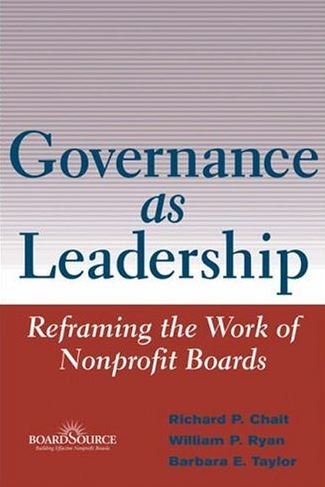Governance as Leadership: Reframing the Work of Nonprofit Boards by Richard P. Chait, ISBN-13: 978-0471684206
[PDF eBook eTextbook]
- Publisher: Wiley; 1st edition (October 22, 2004)
- Language: English
- 224 pages
- ISBN-10: 0471684201
- ISBN-13: 978-0471684206
A new framework for helping nonprofit organizations maximize the effectiveness of their boards.
Written by noted consultants and researchers attuned to the needs of practitioners, Governance as Leadership redefines nonprofit governance. It provides a powerful framework for a new covenant between trustees and executives: more macrogovernance in exchange for less micromanagement.
Informed by theories that have transformed the practice of organizational leadership, this book sheds new light on the traditional fiduciary and strategic work of the board and introduces a critical third dimension of effective trusteeship: generative governance. It serves boards as both a resource of fresh approaches to familiar territory and a lucid guide to important new territory, and provides a road map that leads nonprofit trustees and executives to governance as leadership.
Governance as Leadership was developed in collaboration with BoardSource, the premier resource for practical information, tools and best practices, training, and leadership development for board members of nonprofit organizations. Through its highly acclaimed programs and services, BoardSource enables organizations to fulfill their missions by helping build effective nonprofit boards and offering credible support in solving tough problems.
Table of Contents:
About Boardsource. About the Authors.
Preface.
Acknowledgments.
Chapter 1: First Principles.
Principle One: Nonprofit Managers Have Become Leaders.
Principle Two:Trustees Are Acting More Like Managers.
Principle Three:There Are Three Modes of Governance, All Created Equal.
Principle Four:Three Modes Are Better Than Two or One.
Chapter 2: Problem Boards or Board Problems?
Problems of Performance.
From Problems of Performance to Problems of Purpose.
Some Official Work Is Highly Episodic.
Some Official Work Is Intrinsically Unsatisfying.
Some Important Unofficial Work Is Undemanding.
Some Unofficial Work Is Rewarding but Discouraged.
The Challenge of Reform.
Chapter 3: Type I Governing: Fiduciary.
Type I Governing.
The Type I Mental Map.
The Type I Board.
Assessing the Problems.
Conclusion.
Chapter 4: Type II Governing: Strategic.
Nonprofits Enter the Marketplace.
Boards and Formal Strategy: A Type I Approach to Type II Work.
Strategic Disillusionment.
Strategic Thinking: Beyond a Type I Mindset.
Governing in Type II Mode.
The Evolution of Strategic Governance.
Processes and Structures for Type II Governing.
Implementing Strategy.
Why Not Just Types I and II?
Chapter 5: Type III: Generative Thinking.
The Power of Generative Thinking in Organizations.
Inside the Black Box of Generative Thinking.
Toward Generative Governing.
Leadership as Governance: Executives Displace Trustees.
Governance by Default: Trustees and Executives Disengage.
Governance by Fiat: Trustees Displace Executives.
Type III Governance: Trustees and Executives Collaborate.
Can Boards Do It?
Chapter 6: Type III: Generative Governing.
Using a Type III Mental Map of the Organization.
Recognizing Generative Landmarks.
Generative Landmarks.
Embedded Issues.
Spotting “Triple Helix” Situations.
Working at the Boundary.
Working at the Internal Boundary.
Working at the External Boundary.
Looking Back: The Future in the Rear-View Mirror.
Deliberating and Discussing Differently.
The Cardinal Rule: Suspend the Rules.
Promoting Robust Dialogue.
Mind the Mode.
The Payoffs.
Chapter 7: Working Capital That Makes Governance Work.
Intellectual Capital.
Reputational Capital.
Political Capital.
Social Capital.
Capitalizing on Trustees.
Chapter 8: Where to Next?
Is the Game Worth the Candle?
Diagnostics.
“Attractive Nuisances”.
A New Covenant.
Coming Full Circle.
References.
Index.
RICHARD P. CHAIT is a professor at the Harvard Graduate School of Education. His research and consulting focus is on nonprofit governance and college and university management. He was recently honored as one of Harvard University’s “outstanding teachers.”
WILLIAM P. RYAN is a research fellow at the Hauser Center for Nonprofit Organizations at Harvard University, and a consultant to foundations and non-profit organizations. His work focuses on nonprofit organizational effectiveness and foundation strategy.
BARBARA E. TAYLOR is a researcher and consultant to nonprofit organizations whose work focuses on trusteeship, executive search, and organizational planning and assessment. She is a senior consultant with the Academic Search Consultation Service and a former vice president of the Association of Governing Boards of Universities and Colleges.
What makes us different?
• Instant Download
• Always Competitive Pricing
• 100% Privacy
• FREE Sample Available
• 24-7 LIVE Customer Support









Reviews
There are no reviews yet.